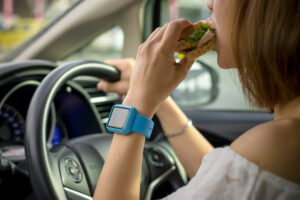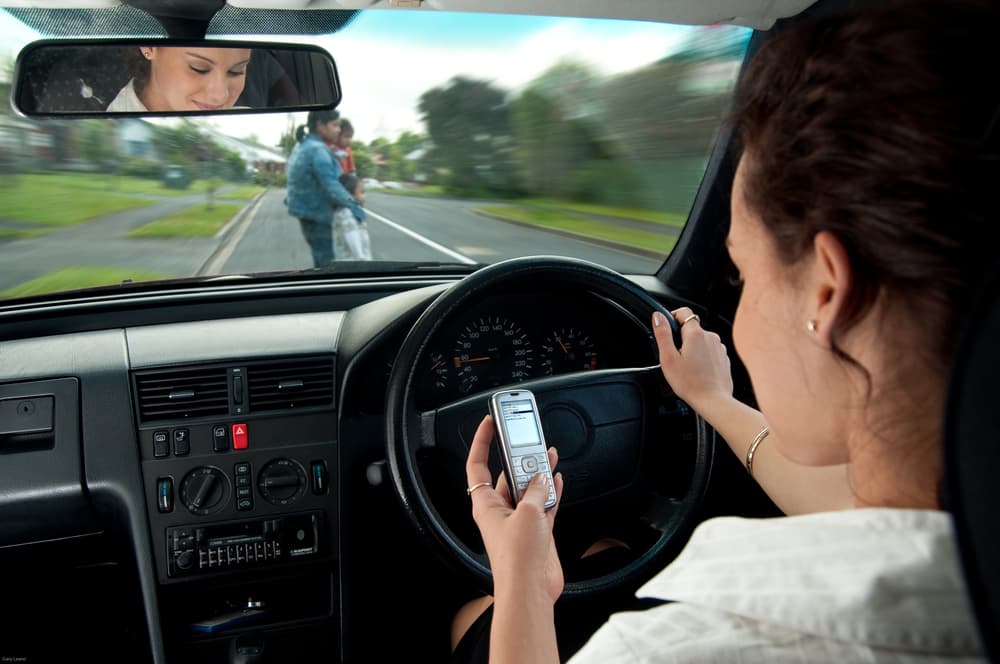Distracted driving is one of the most preventable causes of serious traffic collisions in the United States. When a driver takes their eyes off the road, hands off the wheel, or mind off the task of safe driving, the risk of a crash increases sharply.
From glancing at a cell phone to adjusting a GPS, these moments of inattention can have life-altering consequences for other motorists, passengers, and pedestrians. Identifying the most common types of distractions while driving is an important step toward holding negligent drivers accountable and improving road safety nationwide. If you’ve been injured in a crash caused by a distracted driver, an experienced San Antonio car accident lawyer can help you pursue justice and fair compensation.
Key takeaways
- Distracted driving includes visual, manual, and cognitive activities that interfere with safe operation of a vehicle.
- Cell phone use remains one of the most dangerous distractions, especially texting and app use while driving.
- GPS adjustments, rubbernecking, and interacting with in-vehicle controls can lead to sudden lapses in awareness.
- Eating, grooming, and reaching for objects combine multiple types of distraction and sharply increase crash risk.
- Public awareness campaigns and legislative enforcement are critical tools in reducing distraction-related crashes.
- Technology such as “Do Not Disturb” settings and collision avoidance systems can help prevent accidents.
- Victims of distracted driving accidents may be able to recover compensation for medical costs, lost wages, and other damages.
Distracted driving accident statistics in the United States and Texas

The scale of distracted driving accidents is sobering. According to the National Highway Traffic Safety Administration (NHTSA), 3,275 people were killed in crashes involving distracted drivers in one recent year.
While the distracted driving statistics often focus on fatalities, it’s easy to forget that for every person killed, dozens more are injured, many of them seriously. Federal authorities report that nearly 300,000 people were injured in distracted driving accidents during the same recent year.
These incidents represent thousands of families facing sudden loss, medical costs, and the challenges of recovery.
The Texas Department of Transportation (TxDOT) reports that nearly one in five Texas crashes involves distraction behind the wheel. These collisions killed 373 people and seriously injured 2,587 others in a recent year. In Austin alone, distracted driving is one of the “key four” behaviors most likely to cause severe injury or death in a crash.
These figures highlight a consistent reality: even a momentary lapse in a driver’s attention can lead to devastating outcomes. Let’s break down the most common categories of distraction so that the public, law enforcement, and policymakers can better address this ongoing hazard.
Visual Distractions
Visual distractions occur when a driver’s eyes leave the roadway. Even a brief glance away can be enough to miss a stopped vehicle, a changing traffic signal, or a pedestrian entering a crosswalk.
Smartphone use
Texting, checking social media, or scrolling through notifications are among the leading visual distractions. At 55 miles per hour, looking at a text for five seconds covers the length of a football field without seeing the road ahead. Whether the driver is reading or composing a message, the risk of a collision rises dramatically.
GPS and navigation systems
Modern navigation tools have reduced the likelihood of getting lost, but they have introduced new dangers. Looking down to adjust a route, change settings, or read turn-by-turn instructions diverts a driver’s attention at critical moments.
Rubbernecking at accident scenes or roadside events
Slowing to watch the aftermath of another crash or a roadside incident can trigger sudden traffic slowdowns, rear-end collisions, or lane-change accidents. This form of distraction is both common and preventable.
Manual Distractions
Manual distractions take a driver’s hands away from the steering wheel. While some activities seem harmless, they limit the ability to respond quickly to sudden changes in traffic.
Eating and drinking
Many drivers eat or drink while on the road, whether it’s a quick breakfast during a commute or coffee on the way to work. Unwrapping food, managing spills, or holding a beverage all interfere with the ability to steer and control the vehicle.
Adjusting vehicle controls
Changing the radio station, operating climate controls, or using touchscreen interfaces requires physical interaction that can coincide with moments when immediate steering input is necessary.
Reaching for objects
Grabbing an item from the passenger seat, back seat, or floor combines manual, visual, and sometimes cognitive distractions. In these moments, a driver is less able to maintain lane position or avoid hazards.
Cognitive Distractions
Cognitive distractions take the driver’s mental focus away from driving. Even when hands are on the wheel and eyes are forward, the brain may be preoccupied with something other than the task of driving.
Daydreaming or preoccupation
It is not uncommon for drivers to travel several miles without remembering the details of the trip. This mental drift, particularly in busy traffic, reduces situational awareness and slows reaction time.
Phone conversations, including hands-free
Research shows that hands-free calls do not eliminate the risk posed by cell phone conversations. Processing a discussion while driving divides attention and can impair decision-making.
Intense conversations with passengers
Engaging in emotionally charged or deeply engaging discussions can draw mental focus away from the road. Drivers in these situations may miss traffic signals or fail to anticipate the actions of other motorists.
Other Common Distractions
Some distracting activities do not fit neatly into the three main categories but still contribute to crashes.
- Audible distractions, such as loud music or excessive noise, can diminish your attention. If you’ve ever turned down the volume while trying to find a certain street address or mentioned that the music is so loud, you can’t hear yourself think, you’ve experienced audible distraction.
- Personal grooming, such as applying makeup, shaving, or adjusting hair while driving, combines visual, manual, and cognitive distractions.
- Attending to children or pets can cause a driver to turn away from the road, remove their hands from the wheel, or make unpredictable maneuvers.
- Reading books, maps, or documents, even at low speeds or in heavy traffic, removes visual and cognitive focus from driving.
What Are the Legal Implications of Distracted Driving?
Distracted driving is prohibited in most states, though the scope of the laws and penalties varies widely. In Texas, a statewide ban on texting while driving took effect in 2017. Motorists may not read, write, or send electronic messages while operating a vehicle. A first offense can result in a fine of up to $99, while repeat offenses may carry fines of up to $200.
Additional restrictions apply to certain drivers. Those with learner’s permits are prohibited from using handheld cell phones during the first six months of driving. Drivers under age 18 may not use any wireless communication device, and school bus operators are barred from using a phone while children are on board.
When a distracted driver causes a crash, the consequences can go beyond fines. Criminal charges may apply if the incident results in serious injury or death. Civil liability is also a factor, and injury victims can seek compensation for medical expenses, lost wages, property damage, and other losses. In fatal cases, surviving family members may bring a wrongful death claim.
Evidence in these cases often includes phone records, witness statements, and sometimes vehicle event data. Demonstrating that a driver’s inattention caused a collision is critical to pursuing full and fair compensation.
Prevention Efforts and Public Safety Measures to Fight Distracted Driving
Reducing distracted driving requires action at multiple levels, from public awareness campaigns to stronger enforcement of existing laws. State agencies, community organizations, and traffic safety advocates have developed a range of strategies to address the problem.
Legislative measures
Many states have banned texting while driving, restricted handheld phone use, and implemented enhanced penalties for violations that cause injury or death. These laws aim to deter risky behavior and create a clear legal framework for holding distracted drivers accountable.
Law enforcement campaigns
High-visibility enforcement periods, such as the Put the Phone Away or Pay initiative supported by NHTSA, combine increased patrol presence with public messaging. These efforts remind drivers that distraction-related violations have immediate consequences.
Public awareness initiatives
Campaigns like Texas’s Talk. Text. Crash. emphasize the real-world impact of distracted driving. Through television ads, social media outreach, and community events, these programs highlight stories of victims and the preventable nature of many crashes.
Employer and commercial driver policies
Trucking companies, delivery services, and other businesses with vehicle fleets have adopted strict internal rules against phone use while driving. These policies often exceed state requirements, reflecting the high stakes when large commercial vehicles are involved in collisions.
Technology and Infrastructure Solutions
Technology can be both a cause and a solution for distracted driving. In recent years, automakers and tech companies have introduced tools to help keep drivers focused.
Smartphone features
“Do Not Disturb While Driving” settings can block notifications, send automatic responses, and reduce the temptation to check a device. When enabled, these tools operate automatically once motion is detected.
Vehicle safety systems
Many modern vehicles include lane departure warnings, forward collision alerts, and driver attention monitors. These systems can help mitigate the effects of inattention by alerting the driver to immediate hazards.
Roadway design changes
Rumble strips, highly visible pavement markings, and strategically placed signage can refocus a driver’s attention before a dangerous situation develops. These measures are particularly effective on rural highways where distraction can go unnoticed for longer periods.
The Cost of Distracted Driving Accidents
Many people continue to think of texting and driving as a personal freedom, but it is illegal and a primary offense in states like Texas because it seriously endangers the lives of others, not just the offender.
The financial and human costs of distraction-related crashes extend far beyond the initial impact. Victims may face:
- Emergency medical treatment and hospital stays
- Rehabilitation and long-term care
- Lost income during recovery
- Emotional and psychological trauma
- Permanent disability or loss of life
In severe cases that result in the loss of life, families must also bear the costs of funeral arrangements and the loss of a primary income source. These damages underscore why civil claims for full and fair compensation are essential in holding negligent drivers accountable.
Frequently Asked Questions About Distracted Driving
What evidence can prove a driver was distracted?
Evidence may include phone records, dashcam footage, eyewitness statements, and event data from the vehicle. An attorney can obtain and analyze these records to strengthen a case.
Are hands-free calls considered distracted driving?
In Texas, it is generally legal for adult drivers to make hands-free calls, unless restricted by a local ordinance. State law does prohibit any phone use — hands-free or handheld — for drivers under 18 and for school bus operators when children are present.
Even when allowed, hands-free calls can still cause cognitive distraction. Studies show that the mental focus required for a conversation can slow reaction time and reduce awareness of changing traffic conditions, increasing the risk of a crash.
Can a distracted driving accident result in criminal charges?
If the distraction leads to serious injury or death, the driver may face charges such as reckless driving, vehicular assault, or manslaughter, depending on state law.
Do commercial drivers have different distraction rules?
Federal regulations prohibit commercial drivers from texting and limit handheld phone use. Many companies also have stricter internal policies.
How quickly should someone contact a lawyer after a distracted driving crash?
As soon as possible. Prompt legal action allows for preservation of evidence and ensures that claims are filed within the applicable statute of limitations. Insurance companies may seize on vulnerable crash victims to secure lowball settlements or statements that could diminish their claim for damages.
Holding distracted drivers accountable

When a motorist’s inattention leads to injury or loss of life, those affected have the right to pursue justice through the civil legal system. The process can be complex, especially when proving that distraction directly caused the collision. Skilled representation can make a critical difference in the outcome.
Lorenz & Lorenz, PLLC has been helping crash victims across Central Texas since 2001. Our experienced car accident attorneys understand Texas traffic laws, have a proven record in distracted driving cases, and work on a contingency fee basis. That means you pay no attorney fees unless we recover compensation for you. With a trusted San Antonio personal injury lawyer on your side, you can feel confident knowing your rights are protected every step of the way.
If a distracted driver has harmed you or someone you love, call (512) 477-7333 or contact us online for a free consultation. We will investigate your accident, handle the insurance companies, and fight for the maximum compensation available under the law.
Your recovery matters. Let our team stand up for you.
